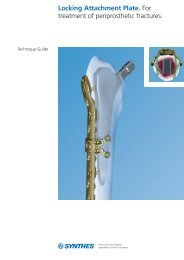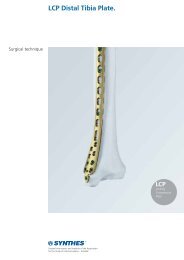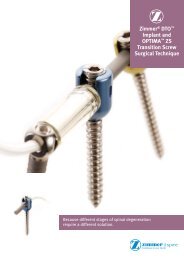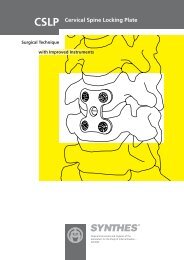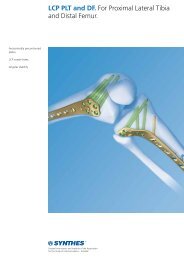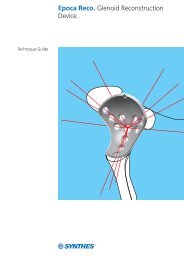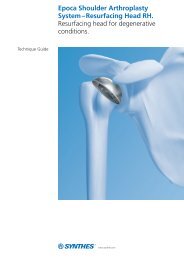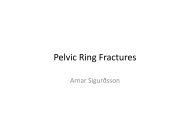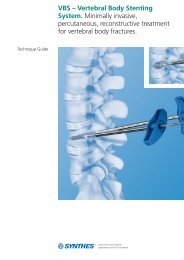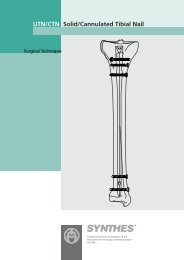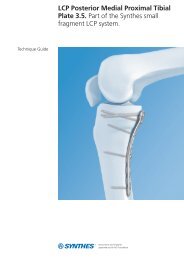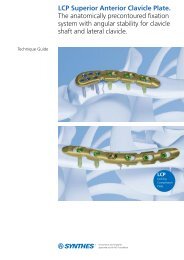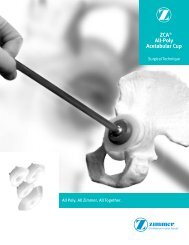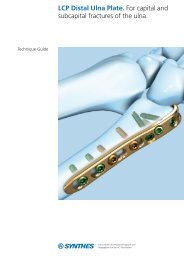[CDATA[CLS® Spotorno® Hip Stem Surgical Technique]] - Zimmer
[CDATA[CLS® Spotorno® Hip Stem Surgical Technique]] - Zimmer
[CDATA[CLS® Spotorno® Hip Stem Surgical Technique]] - Zimmer
Create successful ePaper yourself
Turn your PDF publications into a flip-book with our unique Google optimized e-Paper software.
CLS ® Spotorno ®<br />
<strong>Hip</strong> <strong>Stem</strong><br />
<strong>Surgical</strong> <strong>Technique</strong>
<strong>Surgical</strong> <strong>Technique</strong><br />
CLS Spotorno <strong>Stem</strong><br />
Table of Contents<br />
CLS Spotorno <strong>Stem</strong> 4<br />
Indications for the CLS Spotorno <strong>Stem</strong> 5<br />
Preoperative Planning 10<br />
<strong>Surgical</strong> <strong>Technique</strong> 12<br />
Case Study 21<br />
Ordering Information 22
4 CLS ® Spotorno ® <strong>Hip</strong> <strong>Stem</strong> – <strong>Surgical</strong> <strong>Technique</strong><br />
CLS Spotorno <strong>Stem</strong><br />
The tapered shape of the stem enables<br />
excellent primary stability and ensures<br />
that this stability is maintained thanks t<br />
o the self-stabilizing properties of<br />
the implant. In addition, the structure<br />
of the bone surrounding the prosthesis<br />
shows that the tapered shape of<br />
the implant favours a largely proximal<br />
transfer of load.<br />
As the CCD angle is not a constant value,<br />
and shows broad variability in individuals,<br />
the CLS stem offers three different CCD<br />
angles. This provides a wide range of<br />
offset options, which allows an adequate<br />
restoration of the biomechanical parameters,<br />
such as the center of rotation,<br />
the CCD angle as well as leg length and<br />
soft tissue balancing.<br />
For implantation of the CLS 145°, the<br />
CLS 135° and the CLS 125°, the same<br />
instruments and the same surgical<br />
technique are used. The modular rasps<br />
and trial necks serve the intraoperative<br />
trial reduction.<br />
145°<br />
135°<br />
125°
CLS ® Spotorno ® <strong>Hip</strong> <strong>Stem</strong> – <strong>Surgical</strong> <strong>Technique</strong><br />
5<br />
Indications for the CLS Spotorno <strong>Stem</strong><br />
The Question:<br />
Cemented or Uncemented<br />
The decision between a cemented and<br />
an uncemented hip stem is a choice that<br />
must be made by the surgeon. Based on<br />
the personal experience by the design ing<br />
surgeon implanting over 9,000 CLS<br />
stems, it was possible to carry out<br />
extensive research into the indications<br />
for this stem as well as to define its<br />
limitations.<br />
The results obtained with the CLS stem<br />
since 1984 are excellent*. Even though<br />
excellent results have been achieved<br />
(even under critical conditions), it is still<br />
recommended that surgeons use a set<br />
of standard, reliable criteria to help<br />
make the decision between cemented<br />
and uncemented stems.<br />
* www.jru.orthop.gu.se /<br />
Müller L. et al., “Seventeen-year survival of the cementless CLS Spotorno <strong>Stem</strong>”, 2010
6 CLS ® Spotorno ® <strong>Hip</strong> <strong>Stem</strong> – <strong>Surgical</strong> <strong>Technique</strong><br />
Reliable Decision-Making Through Methodology<br />
In 1985, an indication protocol was<br />
established that is based on the assessment<br />
of four clinical and radiological<br />
parameters in the patient investigated.<br />
Each parameter is given a point score.<br />
The final value obtained from the sum of<br />
the points establishes the indication<br />
and thus, provides a valuable guideline<br />
for the surgeon. The parameters are<br />
age, gender, severity of the osteoporosis<br />
and the anatomical characteristics of the<br />
femur.<br />
Parameter No. 1: Age<br />
As far as skeletal changes are concerned,<br />
it is generally known that age<br />
cannot be considered as a purely<br />
chronological parameter, but has to be<br />
assessed from a biological point of view.<br />
In simple terms, it can be said that for<br />
patients under the age of 50 years, a<br />
cementless stem is the routine solution,<br />
while after the age of 70, a cemented<br />
stem is generally preferred.<br />
Points Allocated<br />
. 70 years: 4 points<br />
61–70 years: 2 points<br />
51–60 years: 1 point<br />
, 50 years: 0 points<br />
Parameter No. 2: Gender<br />
Due to the increasing osteoporosis<br />
resulting from the hormonal changes<br />
occurring during menopause, older<br />
women generally have poorer bone<br />
quality.<br />
Parameter No. 3: Osteoporosis<br />
Severe osteoporosis represents a major<br />
disadvantage in regard to the primary<br />
stability of the implant, or requires the<br />
use of an over-dimensioned stem with<br />
anchorage in the lower metaphyseal<br />
and diaphyseal region. This, in turn, has<br />
a negative effect on the blood supply<br />
to the bone. Radiological methods such<br />
as computer tomography and densiometry<br />
are available for the assessment<br />
of the severity of the osteoporosis.<br />
A suitable method for a conclusive<br />
assessment is the modified analysis<br />
of the trabeculae in the neck of the<br />
femur according to Singh – a process<br />
that is easy to carry out.<br />
Femoral Neck Index<br />
On the basis of these assessments,<br />
four degrees of severity of osteoporosis<br />
can be defined:<br />
Severe (Singh 1–2): 4 points<br />
Moderate (Singh 3–4): 2 points<br />
Slight (Singh 5–6): 1 point<br />
Physiological (Singh 7): 0 points<br />
Points Allocated<br />
Women: 1 point<br />
Men: 0 points<br />
(Singh M. et al. Changes in Trabecular Pattern<br />
of the Upper End of the Femur as an Index<br />
of Osteoporosis. Journal of Bone and Joint<br />
Surgery 52A: 456, 1970).
CLS ® Spotorno ® <strong>Hip</strong> <strong>Stem</strong> – <strong>Surgical</strong> <strong>Technique</strong><br />
7<br />
Stage 1 Stage 2<br />
Parameter No. 4: The Anatomy<br />
of the Femur<br />
The bundle of bow-shaped<br />
trabeculae is missing. The pressure<br />
trajectories in the head<br />
of the femur have partly disappeared.<br />
Stage 3 Stage 4<br />
The bow-shaped trajectories have<br />
almost completely disappeared.<br />
Morpho-Cortical Index<br />
Experience shows that this index provides<br />
more information parameters. It comprises<br />
two variables, which do not always corre -<br />
late with one another, in one single value:<br />
• The morphology of the femur<br />
• The thickness of the cortex<br />
In regard to morphology, it is possible to<br />
differentiate between three types of femurs:<br />
• Trumpet shape<br />
• Cylinder shape<br />
• Dysplastic femur<br />
Partial disappearance of the<br />
bow-shaped trabecular system.<br />
Stage 5<br />
Empty Ward’s triangle. The<br />
accessory trabecular systems<br />
have partly disappeared.<br />
Stage 7<br />
The accessory trabecular systems<br />
have completely disappeared.<br />
Stage 6<br />
The picture of the upper triangle<br />
of the femoral neck appears<br />
to be bound by the bow-shaped<br />
bundle of trajectories of the head<br />
of the femur and the trochanter.<br />
Because of its morphology, the trum petshaped<br />
femur provides the optimal<br />
conditions for an uncemented implant.<br />
The cylindrical femur requires an adequate<br />
cut in the subtrochanteric region and the<br />
removal of metaphyseal bone during the<br />
rasping process. The mechanically supportive<br />
cancellous bone and the cortex of the<br />
isthmus of the calcar, which forms the basis<br />
for the anchorage of the stem, have to be<br />
partly removed.<br />
The morpho-cortical index (MCI), is defined<br />
on a standard X ray picture. It is calculated<br />
from the correlation of the extracortical<br />
diameter of the femur, measured at the<br />
medial tip of the lesser trochanter, to the<br />
intracortical diameter, measured 7 cm<br />
further in the distal direction.<br />
Normal small, dense trabeculae<br />
fill the neck of the femur.<br />
Trajectories are not visible.<br />
(Singh M. et al. Changes in Trabecular Pattern<br />
of the Upper End of the Femur as an Index of<br />
Osteoporosis. Journal of Bone and Joint Surgery<br />
52A:456, 1970).<br />
dysplastic<br />
cylindrical<br />
trumpet-shaped
8 CLS ® Spotorno ® <strong>Hip</strong> <strong>Stem</strong> – <strong>Surgical</strong> <strong>Technique</strong><br />
The MCI is calculated using<br />
the following formula:<br />
CD<br />
MCI =<br />
AB<br />
CD = Distance between the outer<br />
boundaries of the lateral and the medial<br />
cortex. The measurement is made<br />
at the level of the tip of the trochanter,<br />
vertical to the axis of the femur.<br />
AB = Diameter of the medullary cavity.<br />
The measurement is made 7 cm distal<br />
from the CD line, vertical to the axis of<br />
the femur.<br />
C<br />
D<br />
The MCI in this absolute form can only<br />
be used if it was calculated in a standard<br />
X ray picture with the legs in the<br />
normal 0 position and with rectilineal a-p<br />
irradiation.<br />
The pointscores of the MCI<br />
MCI # 2.2: 4 points<br />
MCI . 2.3: 2 points<br />
MCI . 2.7: 1 point<br />
MCI $ 3.0: 0 points<br />
7 cm<br />
A<br />
B<br />
CD<br />
Calculation MCI = AB<br />
Final Assessment<br />
In cases where long-term cortisone<br />
therapy is envisioned, for example in<br />
rheumatoid arthritis, one point must<br />
be added as an additional risk factor.<br />
0–4 points: cementless stem<br />
5 points: questionable indication<br />
$ 6 points: cemented stem
CLS ® Spotorno ® <strong>Hip</strong> <strong>Stem</strong> – <strong>Surgical</strong> <strong>Technique</strong><br />
9<br />
Conclusion: There is a Broad Indication for Uncemented Anchorage<br />
The uncemented stem in general, and<br />
the CLS stem in particular, have definitively<br />
proven their worth. In comparison<br />
with the cemented stem, the uncemented<br />
solution is far more bone conserving.<br />
This becomes an important factor if revision<br />
surgery is necessary.<br />
The insertion of the uncemented stem is<br />
less invasive and takes the biomechanics<br />
of the femur into account. The bone and<br />
the prosthesis combine to form a unit.<br />
As a result, the blood supply and vitality<br />
of the bone are maintained.<br />
In principle, the uncemented stem is<br />
preferably used in younger patients.<br />
It is, however, not contraindicated in the<br />
elderly – especially for patients in poor<br />
general health. It can be implanted more<br />
rapidly and there is no thermal damage<br />
to the tissue due to the cement.<br />
The use of a cemented stem is nevertheless<br />
justified in elderly patients for a<br />
number of reasons:<br />
The life expectancy of the patient is often<br />
shorter than the average survival time<br />
of a cemented stem. In the presence of<br />
poor bone quality, the cement allows<br />
unproblematic correction of defects. With<br />
cementing, faster restoration of the ability<br />
to walk is also to be expected, since –<br />
at least within certain limits – it does not<br />
involve the reparative phase, which, in<br />
the case of the cementless stem, leads to<br />
the definitive anchorage of the bone.<br />
Finally, the economic factor plays a role<br />
that is not to be underestimated.<br />
It can generally be said that if one adheres<br />
to the classical indications – while still<br />
allowing the possibility of further indications<br />
in the future – good and very good<br />
results can be obtained. In this respect,<br />
the use of the MCI is of fundamental<br />
importance because it follows the basic<br />
biomechanical ideas used in the design<br />
of the CLS prosthesis. With a cylindrical<br />
medullary cavity, it is normally necessary<br />
to use a more invasive prosthesis, which<br />
has an unfavourable bone-prosthesis<br />
interaction.<br />
Comparison has shown that the MCI<br />
and the cortical index (CI) after Gruen are<br />
good indicators for the quality of the<br />
bone. There seems to be a connection<br />
both between the CI and the MCI and<br />
between the MCI and the measurement<br />
of the mineral content of the bone by<br />
the Dexa method.
10 CLS ® Spotorno ® <strong>Hip</strong> <strong>Stem</strong> – <strong>Surgical</strong> <strong>Technique</strong><br />
Preoperative Planning<br />
Systematic Preparation with Suitable Methods of Measurement<br />
and Practical Planning Benefit Correct Implantation<br />
Within the framework of the preoperative<br />
planning, the stem size, the optimal<br />
anchorage of the stem in the medullary<br />
cavity and the correct position of the<br />
acetabular and femoral components are<br />
determined in order to ensure equal leg<br />
length.<br />
At the start of the preoperative planning,<br />
three lines are drawn on the X ray picture:<br />
The tangent of the two ischia forms the<br />
base line. A second line is drawn through<br />
the floors of the two acetabulae, and a<br />
third between the lesser trochanters. On<br />
the side that is not to be operated on,<br />
the center of rotation of the joint is determined.<br />
Then the distances between the<br />
joint, baseline and “teardrop” are drawn.<br />
In addition, the longitudinal axis of the<br />
pelvis is also drawn.<br />
Equal leg length: all lines are parallel<br />
The Planning Steps, with an Example<br />
of Unilateral Coxarthrosis<br />
Determination of the Size and<br />
Position of the Cup<br />
The center of rotation of the joint to be<br />
operated on is determined by transposing<br />
the two lines that have been drawn<br />
on the opposite side. The cup template<br />
is then placed on the side that is to be<br />
operated on. The position of the acetabular<br />
components is determined by the<br />
outline of the cup, the center of rotation<br />
that was determined, the level of the<br />
“teardrop” and the required abduction<br />
angle of 40°–45°.<br />
Drawing in of Pelvis and Cup<br />
The tracing paper is placed on the X ray<br />
picture and the template. The longitudinal<br />
edge must run parallel to the vertical<br />
axis of the pelvis. The pelvis and the cup<br />
are drawn in and then the tracing paper<br />
removed from the X ray.
CLS ® Spotorno ® <strong>Hip</strong> <strong>Stem</strong> – <strong>Surgical</strong> <strong>Technique</strong><br />
11<br />
Determination of the CCD Angle,<br />
the Size and Position of the <strong>Stem</strong><br />
First, the most adapted CCD angle of the<br />
CLS stem (125°, 135° or 145°) to fit into<br />
the proximal part of the femur is selected.<br />
The selected stem template is placed<br />
on the femur so that the stem fits into the<br />
medullary canal displaying the correct<br />
type of anchorage. The size of the stem<br />
must be selected so that at least 3 /4 of<br />
the proximal ribbed structure is anchored<br />
in the cancellous bone. Ideally, one of the<br />
four lines from the rotation centers<br />
touches the tip of the greater trochanter.<br />
Height of the Pelvis<br />
The femoral template is to be left in place.<br />
The drawing of the pelvis is placed with<br />
the acetabular components on the X ray<br />
picture. If lengthening of a leg is necessary,<br />
the drawing of the pelvis lies higher<br />
than the pelvis on the X ray picture, by<br />
the difference in the length to be corrected.<br />
In the case of planned shortening of a<br />
leg, the drawing must be correspondingly<br />
lower by the distance to be corrected.<br />
<strong>Stem</strong> size and length must be selected<br />
so that the differences correspond to the<br />
measurements that are to be corrected.<br />
Final Result<br />
The outlines of the femur and the cortex<br />
and the selected implant/femoral head<br />
combination are drawn on the transparent<br />
paper. The distance between the proximal<br />
end of the taper of the stem and the lesser<br />
trochanter is measured and entered.<br />
The line from the shoulder of the stem to<br />
the greater trochanter is extended and<br />
measured. The line between the tip of the<br />
greater trochanter and the center of<br />
rotation is drawn in.
12 CLS ® Spotorno ® <strong>Hip</strong> <strong>Stem</strong> – <strong>Surgical</strong> <strong>Technique</strong><br />
<strong>Surgical</strong> <strong>Technique</strong><br />
Positioning of the Patient:<br />
Placement in the Lateral Position *<br />
The patient is positioned on the operating<br />
table with one pressure pad on the<br />
pubic bone and one on the sacrum. In the<br />
subsequent positioning, it is important<br />
that the pelvis is not lowered, either sideways<br />
or in the caudal direction, and that<br />
it is fixed securely. The leg on the opposite<br />
side is bent 45° at the hip and 90° at the<br />
knee, which helps to stabilize the position<br />
of the patient.<br />
* Different surgical approaches are possible<br />
depending on the surgeon’s preference..
CLS ® Spotorno ® <strong>Hip</strong> <strong>Stem</strong> – <strong>Surgical</strong> <strong>Technique</strong><br />
13<br />
<strong>Surgical</strong> Approach to the <strong>Hip</strong>:<br />
Incision<br />
The posterolateral approach is recommended.<br />
The joint is bent at an angle<br />
between 30° and 40°. A rectilinear incision<br />
is made to the tip of the greater trochanter<br />
and is then continued for about 6 cm<br />
on the diaphysis. After transection of the<br />
subcutis, the fascia lata is exposed.<br />
The Approach to the Deeper Layers<br />
The fascia lata is incised and dissociated<br />
of the fibers of the M. gluteus maximus<br />
and the Charnley wound retractor is placed<br />
directly on the fascia.<br />
In this way, the plane of the external rotator<br />
muscles and the tendon attachment of<br />
the M. gluteus maximus are exposed on<br />
the linea aspera of the femur. The tendon<br />
attachment is partly released in order to<br />
relax the soft parts. This favours the<br />
displacement of the femur in the ventral<br />
direction and also its internal rotation.<br />
Transection of the External<br />
Rotator Muscles and Dislocation<br />
of the <strong>Hip</strong><br />
After inserting a bent Hohmann retractor<br />
under the M. gluteus medius, the tendon<br />
of the M. piriformis is located and<br />
transected, as are some of the tendons of<br />
the external rotator muscles. The joint<br />
capsule is then opened from the dorsocranial<br />
direction. With a combined flexion,<br />
adduction and internal rotation movement,<br />
the head of the femur can now be<br />
dislocated from the acetabulum.
14 CLS ® Spotorno ® <strong>Hip</strong> <strong>Stem</strong> – <strong>Surgical</strong> <strong>Technique</strong><br />
Osteotomy of the Neck<br />
of the Femur<br />
The lesser trochanter serves as reference<br />
point for the osteotomy plane on the neck<br />
of the femur, which was already included<br />
in the preoperative planning. The level<br />
of the osteotomy is influenced by the antetorsion<br />
of the neck of the femur: the<br />
greater the antetorsion, the lower the level<br />
of the osteotomy. Normally, it proves an<br />
advantage to retain 1 to 1.5 cm of the neck<br />
of the femur. This creates a sheath into<br />
which the proximal, ribbed part of the<br />
stem can fit.<br />
The next step is the osteotomy with the<br />
reciprocating saw. Starting from the medial<br />
mark, the upper edge of the neck of the<br />
femur is reached at the point where it rises<br />
from the mass of the trochanter. It may be<br />
necessary to continue the osteotomy with<br />
a cut continued further upwards, parallel<br />
to the axis of the femur.<br />
Preparation of the Medullary<br />
Cavity of the Femur<br />
The leg is turned inwards, by internal<br />
rotation of up to 90°, which is combined<br />
with bending and adduction of the hip.<br />
The lower leg is bent at 90° to the thigh.<br />
This provides a spatial reference point,<br />
in order to be able to establish the antetorsion<br />
of the femoral component of<br />
the prosthesis and its position parallel<br />
to the cortex.<br />
In order to facilitate the exposure of the<br />
mass of the trochanter, a Hohmann retractor<br />
is placed under the lesser trochanter<br />
as a lever, taking care to ensure that the<br />
iliopsoas tendon is not injured. A second<br />
lever is placed at the tip of the greater<br />
trochanter in order to move the muscle to<br />
the side of the diaphysis and to expose<br />
the remaining lateral portion of the neck<br />
of the femur. This has to be removed for<br />
the correct alignment of the stem.<br />
The remaining portion of the neck of the<br />
femur and a small part of the greater<br />
trochanter can be removed with the instrument<br />
provided for this purpose, or directly<br />
with the saw.
CLS ® Spotorno ® <strong>Hip</strong> <strong>Stem</strong> – <strong>Surgical</strong> <strong>Technique</strong><br />
15<br />
Use of the Awl and Rasping<br />
<strong>Technique</strong><br />
The proximal notches on the awl mark the<br />
height of the shoulder of the implant.<br />
The awl has to be inserted laterally and<br />
slightly dorsal. The attachment of the<br />
M. piriformis provides a reference point<br />
for this. As a rule, this corresponds to<br />
the point at which, in the preoperative<br />
planning, the tangent of the endosteal<br />
edge of the outer cortex meets the greater<br />
trochanter. It provides an accurate,<br />
measurable conception of the obstacle<br />
to the prosthesis.<br />
After the medullary space has been<br />
prepared in this way, the awl is inserted<br />
deep, for centering in the canal, taking<br />
care to ensure that it is pressed in the<br />
direction of the greater trochanter. The aim<br />
is to follow the predetermined line towards<br />
the lateral cortex, parallel to the axis of<br />
the femur and to avoid a varus deformity.<br />
The bed for the stem is now prepared,<br />
using rasps of increasing size, until the<br />
highest possible degree of stability is<br />
obtained. The preoperatively measured<br />
distance between the proximal shoulder of<br />
the prosthesis and the greater trochanter<br />
serves as orientation.
16 CLS ® Spotorno ® <strong>Hip</strong> <strong>Stem</strong> – <strong>Surgical</strong> <strong>Technique</strong><br />
The desired stability is based on the<br />
concept of a press-fit in the cortex and<br />
cancellous bone. This is why the rasps<br />
have smooth zones for compression<br />
of the cancellous bone and cutting zones<br />
for rasping of parts of the cortex. *<br />
After the surgeon has established the size<br />
of the prosthesis during the planning, the<br />
definite size is determined by progressive,<br />
stepwise rasping, starting with 3 to 4<br />
smaller rasp sizes. In this way, using the<br />
increasing dimensions, the cancellous<br />
bone is compressed. Where necessary,<br />
the cortex has to be reamed. The rasps are<br />
inserted with small, precise hammer blows,<br />
and then withdrawn.<br />
The final, definitive reaming must be<br />
carried out only with the rasp planned for<br />
this. The last rasp should be operated<br />
manually.<br />
* The rasp is designed to lead to a defined smaller dimension<br />
in relation to the bony structure of the femur.<br />
Generally, it is underdimensioned in the proximal portion<br />
of the rasp – that is, the portion with which cancellous<br />
bone is to be compressed.<br />
At the distal end, the rasp is slightly oversized, in order<br />
to prevent stress peaks on the end of the prosthesis.
CLS ® Spotorno ® <strong>Hip</strong> <strong>Stem</strong> – <strong>Surgical</strong> <strong>Technique</strong><br />
17<br />
Rasping <strong>Technique</strong><br />
With the first rasp, care must be taken to<br />
ensure a correct antetorsion (10–15°).<br />
This can be monitored by means of the<br />
handle of the rasp. The neck of the femur<br />
may display a pathological antetorsion,<br />
which the surgeon has to take into account<br />
and possibly rectify. This can be done, for<br />
example, by a lower osteotomy of the neck<br />
of the femur or by controlled splitting.<br />
According to the safety margin concept,<br />
the sum of the antetorsion of the femur<br />
and the anteversion of the acetabulum<br />
must be 25 ± 7°. One should, however, try<br />
to keep the angle between the two components<br />
of the prosthesis as close as possible<br />
to the physiological angle.<br />
10–15°<br />
The reference parameter for the correct<br />
alignment of the rasp is the plane running<br />
through the axis of the diaphysis and<br />
parallel to the condyles of the femur.<br />
Keeping the angle of the bend of the lower<br />
leg at 90°, vertical to the floor, the rasp<br />
is turned 15° downwards. The ideal angle,<br />
which is formed from the lower leg and<br />
the long bar of the rasp, can be checked<br />
visually.
18 CLS ® Spotorno ® <strong>Hip</strong> <strong>Stem</strong> – <strong>Surgical</strong> <strong>Technique</strong><br />
Trial Repositioning with Trial Neck<br />
Trial reduction of the CLS stem may be<br />
accomplished with the rasp.<br />
This is done by removing the rasp handle<br />
and leaving the rasp in the femoral<br />
canal. A trial neck is then inserted into<br />
the rasp hole. Once the trial neck is<br />
selected, any of the trial heads may be<br />
used in conjunction with the trial neck.<br />
For the CLS stem, different trial necks<br />
have to be used in order to correctly<br />
reproduce the different offset options.<br />
Once the trial neck and the appropriate<br />
trial head are selected, the hip is reduced.<br />
Leg length and offset are checked. This<br />
procedure is repeated as necessary,<br />
using trial heads of different lengths, until<br />
optimal offset, leg length and stability<br />
are established. A trial reduction should<br />
not allow significant push-pull or “shuck”<br />
of the joint in full extension. The range of<br />
motion is checked to avoid bony impingement<br />
and instability.<br />
Insertion of the <strong>Stem</strong><br />
After removal of the rasp, a prosthesis<br />
of the appropriate size is inserted and<br />
driven in until it is completely stable.<br />
In this process, it is important to proceed<br />
with the necessary light touch. This is<br />
learned with experience. It should be<br />
remembered that because of the wedge<br />
mechanism, an excessive load may be<br />
exerted that can bear on the trochanter<br />
to the point that it might cause a fracture.<br />
It is important to adjust the force of the<br />
hammer blows, according to the quality<br />
of the bone and to stop the hammer<br />
blows immediately if a change in the<br />
sound of the blows, from dull (cancellous<br />
bone) to sharp (cortex) is perceived.
CLS ® Spotorno ® <strong>Hip</strong> <strong>Stem</strong> – <strong>Surgical</strong> <strong>Technique</strong><br />
19<br />
Assembly of the Femoral Head<br />
and Repositioning<br />
After insertion of the prosthesis, the<br />
definitive femoral head is established on<br />
the basis of the measurements laid<br />
down in the preoperative planning and by<br />
trial repositioning using trial heads.<br />
The last step in the assembly is the fitting<br />
of the previously defined head onto<br />
the stem. After thoroughly cleaning and<br />
drying the taper, the femoral head is<br />
mounted with a light rotational movement<br />
and rotated further with axial force until<br />
it is firmly seated. The femoral head is<br />
seated with one light hammer blow on<br />
the head impactor in axial direction.<br />
Upon reducing the joint, the surgeon<br />
checks the range of motion and stability<br />
of the joint. This should be checked<br />
with both internal and external rotation.<br />
Intraoperative Extraction<br />
of the <strong>Stem</strong><br />
If the stem needs to be removed intraoperatively<br />
only the specific extraction<br />
instrument has to be used, which<br />
protects the neck and the cone of the<br />
stem. Slide the extraction instrument<br />
over the stem taper, until the plastic jaws<br />
reach the neck of the stem. It is very<br />
important that the plastic jaws touch only<br />
the neck and not the taper. Afterwards<br />
tighten the plastic jaws with the ball hex<br />
screwdriver, until the extraction<br />
instrument is firmly fixed on the stem.<br />
Remove the stem by hammering on<br />
the extraction instrument.<br />
Important: The extraction instrument<br />
can be used only for intraoperative stem<br />
extraction. It is not suitable for revision<br />
cases.<br />
The plastic jaws can be exchanged if<br />
necessary.<br />
With the placing of drains and suturing<br />
of the different layers, the operation is<br />
now complete.<br />
Intraoperative extraction of the stem
20 CLS ® Spotorno ® <strong>Hip</strong> <strong>Stem</strong> – <strong>Surgical</strong> <strong>Technique</strong><br />
Disassembly of the Extraction<br />
Instrument<br />
For cleaning and sterilization as well<br />
as for the exchange of the plastic jaws<br />
Unlock screw with screwdriver for<br />
extraction instrument<br />
Remove screw from plastic jaw<br />
Extract fixed plastic jaw with the impactor<br />
according to the illustration<br />
The disassembled instrument can<br />
now be cleaned and sterilized<br />
Note:<br />
Damaged plastic jaws have<br />
to be replaced!
CLS ® Spotorno ® <strong>Hip</strong> <strong>Stem</strong> – <strong>Surgical</strong> <strong>Technique</strong><br />
21<br />
Case Study<br />
CLS Spotorno<br />
stem 145° and<br />
CLS Spotorno<br />
expansion cup<br />
preoperative<br />
postoperative 15.8 years
22 CLS ® Spotorno ® <strong>Hip</strong> <strong>Stem</strong> – <strong>Surgical</strong> <strong>Technique</strong><br />
Implants<br />
CLS ® Spotorno ® 145° <strong>Stem</strong><br />
CLS ® Spotorno ® 135° <strong>Stem</strong><br />
CLS ® Spotorno ® 125° <strong>Stem</strong><br />
CLS ® Spotorno ® 145° HAC <strong>Stem</strong><br />
Details<br />
Protasul ® -100<br />
Uncemented<br />
L. Spotorno<br />
Details<br />
Protasul ® -100<br />
Uncemented<br />
L. Spotorno<br />
Details<br />
Protasul ® -100<br />
Uncemented<br />
L. Spotorno<br />
Details<br />
Protasul ® -100/HAC<br />
Uncemented<br />
L. Spotorno<br />
145° 135°<br />
125° 145°<br />
STERILE R<br />
STERILE R<br />
STERILE R<br />
STERILE R<br />
size in mm REF<br />
5.00 29.00.09-050<br />
6.00 29.00.09-060<br />
7.00 29.00.09-070<br />
8.00 29.00.09-080<br />
9.00 29.00.09-090<br />
10.00 29.00.09-100<br />
11.25 29.00.09-112<br />
12.50 29.00.09-125<br />
13.75 29.00.09-137<br />
15.00 29.00.09-150<br />
16.25 29.00.09-162<br />
17.50 29.00.09-175<br />
20.00 29.00.09-200<br />
size in mm REF<br />
5.00 29.00.39-050<br />
6.00 29.00.39-060<br />
7.00 29.00.39-070<br />
8.00 29.00.39-080<br />
9.00 29.00.39-090<br />
10.00 29.00.39-100<br />
11.25 29.00.39-112<br />
12.50 29.00.39-125<br />
13.75 29.00.39-137<br />
15.00 29.00.39-150<br />
16.25 29.00.39-162<br />
17.50 29.00.39-175<br />
20.00 29.00.39-200<br />
size in mm REF<br />
5.00 01.00295.005<br />
6.00 01.00295.006<br />
7.00 01.00295.007<br />
8.00 01.00295.008<br />
9.00 01.00295.009<br />
10.00 01.00295.010<br />
11.25 01.00295.011<br />
12.50 01.00295.012<br />
13.75 01.00295.013<br />
15.00 01.00295.015<br />
16.25 01.00295.016<br />
17.50 01.00295.017<br />
20.00 01.00295.020<br />
size in mm REF<br />
5.00 29.00.59-050<br />
6.00 29.00.59-060<br />
7.00 29.00.59-070<br />
8.00 29.00.59-080<br />
9.00 29.00.59-090<br />
10.00 29.00.59-100<br />
11.25 29.00.59-112<br />
12.50 29.00.59-125<br />
13.75 29.00.59-137<br />
15.00 29.00.59-150<br />
16.25 29.00.59-162<br />
17.50 29.00.59-175<br />
20.00 29.00.59-200
CLS ® Spotorno ® <strong>Hip</strong> <strong>Stem</strong> – <strong>Surgical</strong> <strong>Technique</strong><br />
23<br />
Instruments<br />
Handle for modular rasp<br />
REF<br />
01.00299.100<br />
Long bar<br />
REF<br />
70.00.01<br />
Tray (complete)<br />
REF<br />
ZS 01.00298.110<br />
Standard container cover<br />
REF<br />
01.00029.031<br />
Tray (empty)<br />
REF<br />
01.00298.110<br />
Insert for tray (empty)<br />
REF<br />
01.00298.102<br />
Rasp modular<br />
size in mm<br />
REF<br />
5.00 01.00299.105<br />
6.00 01.00299.106<br />
7.00 01.00299.107<br />
8.00 01.00299.108<br />
9.00 01.00299.109<br />
10.00 01.00299.110<br />
11.25 01.00299.111<br />
12.50 01.00299.112<br />
13.75 01.00299.113<br />
15.00 01.00299.115<br />
16.25 01.00299.116<br />
17.50 01.00299.117<br />
20.00 01.00299.120
24 CLS ® Spotorno ® <strong>Hip</strong> <strong>Stem</strong> – <strong>Surgical</strong> <strong>Technique</strong><br />
Trial neck<br />
CLS<br />
REF<br />
125° 01.00299.125<br />
135° 01.00299.135<br />
145° 01.00299.145<br />
Repositioning tops<br />
mm<br />
REF<br />
28 78.00.38-28<br />
32 78.00.38-32<br />
Impactor<br />
REF<br />
75.00.36<br />
Trial heads<br />
x 28<br />
REF<br />
12/14 S 01.01559.128<br />
12/14 M 01.01559.228<br />
12/14 L 01.01559.328<br />
12/14 XL 01.01559.428<br />
Double-curved gauge<br />
mm<br />
REF<br />
9 75.09.15<br />
Ruler<br />
mm<br />
REF<br />
20 95.00.03<br />
x 32<br />
REF<br />
12/14 S 01.01559.132<br />
12/14 M 01.01559.232<br />
12/14 L 01.01559.332<br />
12/14 XL 01.01559.432<br />
Boxed chisel<br />
REF<br />
75.13.02-10<br />
Extraction instrument for stem<br />
REF<br />
01.00529.102<br />
Repositioning lever<br />
REF<br />
75.11.00-02<br />
Awl<br />
REF<br />
70.08.89<br />
Screwdriver for extraction instrument<br />
REF<br />
01.00529.101
CLS ® Spotorno ® <strong>Hip</strong> <strong>Stem</strong> – <strong>Surgical</strong> <strong>Technique</strong><br />
25<br />
Upon Request<br />
Handle for modular rasp with IMT<br />
REF<br />
01.00299.101<br />
Plastic jaws for 01.00529.102<br />
REF<br />
01.00529.103<br />
Trial heads<br />
x 36<br />
REF<br />
12/14 S 01.01559.136<br />
12/14 M 01.01559.236<br />
12/14 L 01.01559.336<br />
12/14 XL 01.01559.436<br />
Repositioning tops<br />
mm<br />
REF<br />
36 78.00.38-36
Disclaimer<br />
This documentation is intended exclusively for physicians and is not intended for laypersons.<br />
Information on the products and procedures contained in this document is of a general nature and does not represent<br />
and does not constitute medical advice or recommendations. Because this information does not purport to constitute<br />
any diagnostic or therapeutic statement with regard to any individual medical case, each patient must be examined and<br />
advised individually, and this document does not replace the need for such examination and/or advice in whole or in part.<br />
Please refer to the package inserts for important product information, including, but not limited to, contraindications,<br />
warnings, precautions, and adverse effects.<br />
Copyright 2008–2011 by <strong>Zimmer</strong> GmbH Printed in Switzerland Subject to change without notice<br />
Contact your <strong>Zimmer</strong> representative or visit us at www.zimmer.com<br />
Lit. No. 06.01297.012 – Ed. 2011-01 ZHUB<br />
+H84406012970121/$110101A11Q


![[CDATA[CLS® Spotorno® Hip Stem Surgical Technique]] - Zimmer](https://img.yumpu.com/35378214/1/500x640/cdataclsar-spotornoar-hip-stem-surgical-technique-zimmer.jpg)
